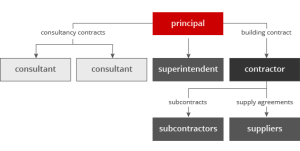Chapter 2 Construct Only
Overview
The principal engages:
- first, design consultants to prepare a complete design (drawings and specifications) for the project; and
- second, a contractor to build the project in compliance with that design.
This is considered to be the delivery method with the lowest risk for contractors and is a popular delivery method for small scale projects on domestic buildings, commercial buildings and infrastructure work.
Construct only is the most appropriate delivery method to use where there is little value to the owner for the construction contractor to be involved in the design process, particularly where the design is not complex.
Contractual relationships
The principal enters into a contract with the design consultants, which enables the principal to control the design process. The design consultants retain liability for the design that the contractor uses.
Once the design has been fully developed the principal enters into a contract with the contractor to construct the project according to the design. The contractor may then engage subcontractors and suppliers to provide particular goods and services required to complete construction. The contractor is responsible for the construction of the project, including the work of subcontractors and suppliers. The contractor is not responsible for the design, but is liable for constructing the project according to the design.
Generally, the principal engages a superintendent to administer the building contract during the construction phase. The superintendent may be one of the design consultants. However, careful consideration should be given to any potential conflict of interest arising from a dual role as superintendent and designer.

Advantages
- A very well known and understood method.
- The principal retains control over the design and quality.
- Low risk for the contractor – only responsible for construction, not design.
- Well established standard form contracts are available.
Disadvantages
- The principal does not gain any design input from the contractor, which diminishes opportunities for cost saving and value (eg no buildability input from builder).
- Preparing the full design before engaging a contractor may increase the time taken for the whole project compared to other delivery methods.
- The principal does not have a single party responsible for both design and construction.
- If the design has errors or inconsistencies, the contractor may be entitled to extra time and money over and above the initial contract sum as a result of variations.
Standard form contracts
Standards Australia contracts
In Australia there are a number of construction contracts which have been prepared by industry bodies and representative groups and are widely used in the industry. These include:
AS 2124-1992: General Conditions of Contract
AS 2545-1993: Subcontract Conditions
AS 4000-1997: General Conditions of Contract
AS 4901-1998: Subcontract Conditions
AS 4905-2002: Minor Works Contract Conditions (Superintendent Administered)
AS 4906-2002: Minor Works Contract Conditions (Principal Administered)
Other industry standard contracts
PC-1 (1998)
GC 21 Edition 2
ABIC MW-2018: Major works
